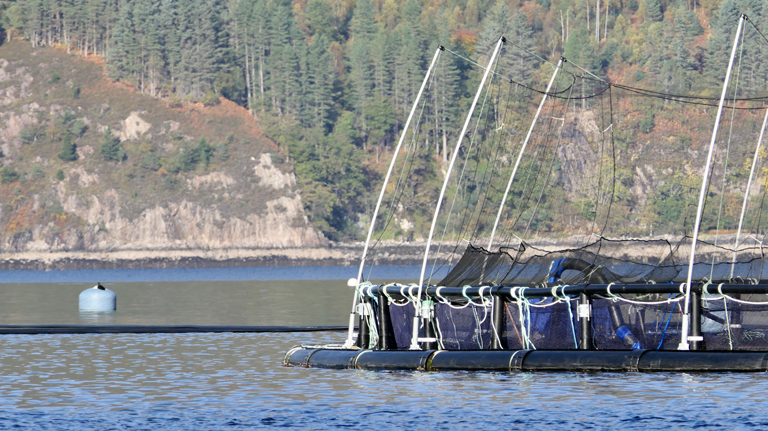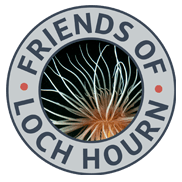Salmon Farming and Loch Hourn
Salmon farming has been a feature of Loch Hourn since the 1990s, beginning with Ian Anderson’s Strathaird Salmon Ltd at small sites in the mid and inner loch.
Marine Harvest then was granted a lease over the Creag An T-Sagairt close to the mouth of the loch in 1998 and all salmon production was located at this site.
Since that time the size of the farm has increased incrementally from less than 2000 tonnes maximum biomass reaching a high of 3300 tonnes in 2015 resulting in seabed damage and a subsequent imposition of a reduction to 2500 tonnes by SEPA.
The application to increase production to 3100 tonnes represents a further massive increase in infrastructure, seabed area and the appearance of an industrial site.
Additional Information
Arnisdale River Salmon Catches 1980 – 2020

Figure: Chart showing salmon and grilse numbers per year since 1980. Salmon numbers have dropped significantly during this period, but it is especially noticeable after 1990 after the arrival of Straithaird Salmon Farm in 1987. Grisle remained low apart from during the period when Arnisdale Estate was restocking with juvenile hatchery bred salmon. There is now a presumption against restocking due to the adverse effects this can have on existing wild salmon populations.
Loch Hourn Sea Lice Modelling Report Summary
This summary of a sixty-one-page report shows that if Mowi’s plans are approved, it would tip the distinct populations of Loch Hourn salmon and trout towards extinction.

A local fisherman’s view…
I’ve lived on the south shore of Loch Hourn since 1975. I work as a fisherman, these days catching prawns, but in the past I’ve also fished for crabs, lobsters, and dived for scallops. In some ways very little has changed – it is still beautiful, it is still isolated, there’s still nowhere I’d rather be. Personally, some things have got easier. We have electricity, a phone line, the internet, satellite TV, a good sized boat, all things that were absent in the early days.
When a fish farm first came to Loch Hourn, in the early nineties, it didn’t seem like too much of a threat, just another group of people trying to make a living from the sea. It was owned by Ian Anderson, of Jethro Tull fame, and was of a modest size with the fish being hand fed by quite a good sized workforce. Those were innocent times when the full impact of open cage fish farming was not widely appreciated. Problems did arise, as when the whole operation up near the head of the loch had to be closed down due to furunculosis. Not enough tidal flushing. It became apparent that you couldn’t just put a fish farm anywhere you wanted and hope the sea would keep it all healthy.
Strathaird Salmon then sold out to Marine Harvest (now rebranded as Mowi) and the site began to grow. It is now serviced by a fleet of Mowi owned ships that could never be run by a small independent outfit, which pass the house on their way to the farm. Well boats, tugs, landing craft, thermolicers, feed boats, and others that are too specialised to even tell what they are.
But perhaps that would have been no more than a slight annoyance if the farm was a wholesome operation, providing a few local jobs and some wider economic benefits, without causing any serious harm. Unfortunately that is not how things have turned out.
The most obvious damage has been to the local salmon and sea trout populations. It was common to see salmon and sea trout jumping in front of the house; now there are never salmon to be seen and the sea trout maybe a handful of times a year.
Back then if you put out a net, which one really shouldn’t have done, you would quickly catch a salmon or some trout for the pot. ‘Kenny Salmon’ even had a commercial salmon netting station across the sound at Isle Ornsay, but all that has long gone now. It is undeniable that up and down the West Coast wild salmon populations have been virtually destroyed, yet still the industry seeks to expand, with ‘modelling’ and ‘Envionmental Impact Assessments’ that try to pretend that nothing bad is happening here.
Other damage is not so easy to see as it is mostly hidden underwater, but is none the less real. One thing that did show up recently is the almost total loss of the mussel colonies in the inner lochs and there are fewer lobsters to be caught.


No salmon farmer likes to think that disasters can happen to them, but Mowi, or Marine Harvest as it was then, have had their fair share.
Back in 1999 they had a mass mortality event in the loch with around 600 tons of salmon dying and a major clean-up operation required. There was an oily, fishy, smell throughout the loch and a white scum along the entire high tide line. A succession of lorries were needed to take the dead and stinking fish away. Later, in 2019, they lost another 257 tons to Cardiomyopathy Syndrome.
However over the years I have had many positive interactions with the people who work the farm and they have been very obliging and helpful to me on a personal level.
Among other things they have towed me to safety, helped with the delivery of heavy items and let me use their jetty when the tide was low. It is sad that now there is local resentment because of the way the multinational parent company is behaving. It’s not the fault of the local people who work there but of ‘head office’ who seem hell bent on this relentless expansion no matter the consequences or the concerns of the local population.
